List of people who have been considered deities
This is a list of notable people who were considered deities by themselves or others.
Imperial cults
| Who | Image | When | Notability |
|---|---|---|---|
| Pharaohs |  |
3050 BCE–30 BCE | Egyptian pharaohs were kings of Ancient Egypt, and were considered gods by their culture. Their titles equated them with aspects of the likes of the hawk god Horus, the vulture goddess Nekhbet, and the cobra-goddess Wadjet. The Egyptians believed that when their Pharaoh died, he would continue to lead them in the next life, which is why his burial was grand and completed to perfection—to please him in the next life and ensure his immortality to protect his people. See List of pharaohs.[1][2] |
| Japanese emperors | |
660 BCE–present | Claimed, at least by some Shintoists, including government officials, to be divine descendants of the goddess Amaterasu. Hirohito, the Showa emperor, repudiated the "false conception" of his divinity in the Humanity Declaration in 1945.[3] |
| Chinese emperors |  |
221 BCE–1911 CE | Deified as "Sons of Heaven" since the Qin Dynasty under Qin Shi Huang.[4] |
| Roman emperors |  |
42 BCE – 363 CE | Following Julius Caesar who in 42 BCE was formally deified as "the Divine Julius", and Caesar Augustus henceforth became Divi filius ("Son of the Divine One"), some (not all) Roman Emperors of the 1st to 4th centuries claimed divinity, including Tiberius 14–37, Caligula 37–41, Claudius 41–54, Hadrian 117–138, Commodus 161–192, Constantine I 306–312, Julian the Apostate 361–363 |
| Natchez rulers | |
700 CE | The Natchez were a theocracy ruled by "The Great Sun." This ruler has sometimes been deemed a God-king.[5] |
| The Sailendras | |
700 CE | The Sailendra dynasty of Java were active promoters of Mahayana Buddhism and covered the plains of Central Java with Buddhist monuments, including the world-famous Borobudur.[6] |
| Majapahit kings |  |
1293–1597 | Javanese rulers of South East Asia's largest ever kingdom, in Indonesia. After death, they were depicted as Hindu gods (see for instance Raden Wijaya). |
| Dalai Lamas |  |
1391–present | Considered re-incarnations of Avalokiteśvara in Tibetan Buddhism. Panchen Lamas are incarnations of Amitābha.[7][8][9] |
| Inca emperors | 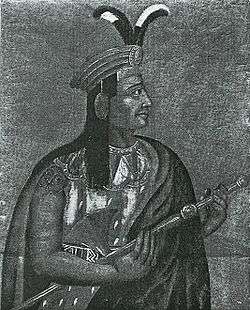 |
1438 | The Inca Emperors had a status very similar to that of the Pharaohs of Egypt. |
| Nepalese kings | .jpg) |
1768–2008 | In Nepal, the kings of the Shah dynasty were considered incarnations of Vishnu. |
Posthumous deification
Main article: Apotheosis
| Who | Image | When | Notability |
|---|---|---|---|
| Imhotep | |
2600 BCE | Ancient Egyptian architect and physician, who two thousand years after his death, was raised to that of a god, becoming the god of medicine and healing. |
| Queen Dido of Carthage |  |
814 BCE | Founder and first queen of Carthage, after her death, she was deified by her people with the name of Tanit and assimilated to the Great Goddess Astarte (Roman Juno).[10] The cult of Tanit survived Carthage's destruction by the Romans; it was introduced to Rome itself by Emperor Septimius Severus, himself born in North Africa. It was extinguished completely with the Theodosian decrees of the late 4th century. |
| Homer |  |
8th century BCE | Venerated at Alexandria by Ptolemy IV Philopator. |
| Romulus and Remus | 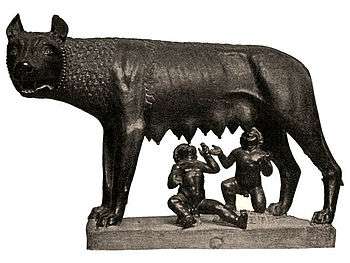 |
771 BCE–717 BCE | Founders of Rome, sons of Mars, Romulus served as first king. After his death, Romulus was defined as the god Quirinus, the divine persona of the Roman people. He is now regarded as a mythological figure, and his name a back-formation from the name Rome, which may ultimately derive from a word for "river". Some scholars, notably Andrea Carandini believe in the historicity of Romulus, in part because of the 1988 discovery of the Murus Romuli on the north slope of the Palatine Hill in Rome.[11] |
| Siddhārtha Gautama Buddha | .jpg) |
563 BCE (?) | Believed a god by some Mahayana sects, and worshipped as an avatar of Vishnu by some Vaishnavas. |
| Hephaestion |  |
356 BCE–324 BCE | Deified by Alexander the Great |
| Alexander the Great | 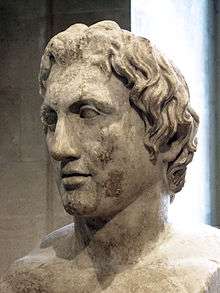 |
356 BCE–323 BCE | Some believe he implied he was a demigod by actively using the title "Son of Ammon–Zeus". The title was bestowed upon him by Egyptian priests of the god Ammon at the Oracle of the god at the Siwah oasis in the Libyan Desert.[12] |
| Antinous |  |
111 CE–130 CE | Deified by Hadrian. He is the last non-Imperial human formally deified in Western civilization. |
| Mary, mother of Jesus |  |
300 CE | In 300 AD she was worshipped as a Mother Goddess in the Christian sect Collyridianism, which was found throughout the Thrace. Collyridianism was made up mostly of women followers and female priests. Followers of Collyridianism were known to make bread and wheat offerings to the Virgin Mary, along with other sacrificial practices. The cult was heavily condemned as heretical and schismatic by other Christians and was preached against by Epiphanius of Salamis, who discussed the group in his recollective writings titled Panarion. |
| Guan Yu |  |
581 CE–618 CE | Guan Yu has been deified as early as the Sui Dynasty and is still popularly worshipped today among the Chinese people variedly as an indigenous Chinese deity, a bodhisattva in Buddhism and a guardian deity in Taoism. He is also held in high esteem in Confucianism. In Hong Kong both police and gangsters consider him a divine object of reverence. In certain schools of Taoism and Chinese Buddhism he has been deemed divine or semi-divine status. The reverence for him may date back to the Sui dynasty.[13] |
| Alī ibn Abī Ṭālib |  |
599 CE–661 CE | According to the Alawite faith, Ali ibn Abi Talib is one member of a trinity (Ali-Muhammad-Salman the Persian) corresponding roughly to the Christian Father, Son, and Holy Spirit. He is considered the second emanation of God by Yarsan and the supreme deity in Ali-Illahism. |
| Sugawara no Michizane |  |
845 CE–903 CE | Japanese Imperial courtier banished from the capital and deified upon his death to appease his angry spirit. Worshipped as Tenjin, kami of scholarship. |
| El-Hakem b'Amr Allah | 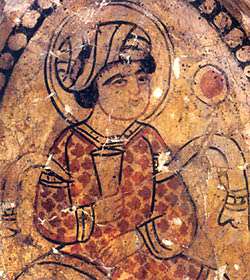 |
985 CE–1021 CE | Sixth Fatimid Caliph in Egypt, ruling from 996 to 1021. The members of the Druze faith believe that the Fatimid Caliph Al-Hakim bi-Amr Allah is the Mahdi. The Muslim scholar and early preacher Nashtakin ad-Darazi claimed that the Caliph was God incarnate. Because of that he was executed by al hakim who did not proclaim he that he was God. The druze today do reject Ad-Darazi's preaching completely[14][15][16][17][18] |
| Tokugawa Ieyasu | 1616 | Deified posthumously with the name Tōshō Daigongen by his successors. | |
| George Washington |  |
1865 | Worshiped as a kami in Hawaiian Shinto shrines.[19] In the United States Capitol dome, he is also depicted ascending into Heaven and becoming a god, in the famous painting called The Apotheosis of Washington. |
| Kanichi Otsuka | 1891 | Shinreikyo states of its founder "God became one with a human body, appeared among humanity, and founded Shinreikyo."[20] | |
| L. L. Zamenhof |  |
20th century | Considered a god by members of the Oomoto religion. |
| José Rizal | 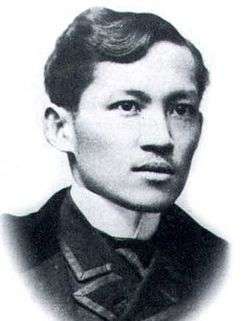 |
20th century | Deified by some people in the Philippines due to his contributions to the Philippine Revolution.[21][22] |
| Wallace Fard Muhammad | Link to image | 20th century | Posthumously (?) deified by Elijah Muhammad. He is also given other titles by the Nation of Islam.[23] |
| Mother Teresa | 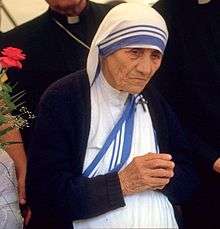 |
1997 | Worshipped as a Hindu goddess by some inhabitants of Kolkata.[24] |
Involuntary deification
| Who | Image | When | Notability |
|---|---|---|---|
| Ezra |  |
458 BC | Ezra established Second Temple Judaism[25] and is regarded as a very important figure in Judaism.[26] The Quran claims that a group of Jews, often interpreted as the Yemenite Jews, believed Uzair was the son of God.[Quran 9:30][27] |
| Antiochus II Theos |  |
286 BCE–246 BCE | Seleucid ruler. The younger son of Antiochus I and Stratonice, succeeded his father in 261. He liberated Ephesus, Ionia, Cilicia and Pamphylia from Egyptian domination, and in return for their autonomy the cities of Asia Minor gave him the title Theos ("God").[28] |
| Zheng He |  |
1371–1433 | Worshiped by some Chinese and South East Asians.[29] |
| Kumari |  |
~17th century–present | These are little girls who are worshipped by both Hindus and Buddhists as the incarnation of the Hindu Goddess Durga (Nepali Taleju) in Nepal. They are picked when they are prepubescent and are worshipped until they reach puberty. Their cult is in South Asian countries, especially in Nepal. |
| John Nicholson | 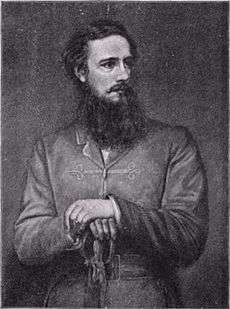 |
19th century | Inspired the cult of Nikal Seyn. |
| Jiddu Krishnamurti |  |
1909 | Renounced the status of messiah and Maitreya incarnation given him by the Theosophical Society. |
| Haile Selassie I | 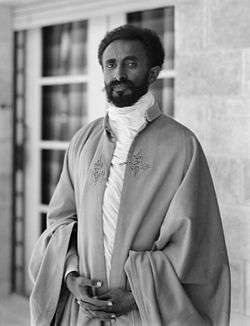 |
1930s | Among most followers of the Rastafari movement, Haile Selassie is seen as the second coming of Jesus Christ, God incarnate, the Black Messiah and "Earth's Rightful Ruler" who will also lead African peoples to freedom. Rastas say that his royal titles (i.e. King of Kings, Conquering Lion of the Tribe of Judah, and Root of David) were prophesied as belonging to the returned Messiah in Revelation 5:5. Their faith in his divinity first appeared in Jamaica, soon after his 1930 coronation in Addis Ababa.[30] Before his coronation he was called Ras (meaning Prince) Tafari. |
| Prince Philip, Duke of Edinburgh |  |
1950s~1960s | Considered a god in the village of Yaohnanen, a cargo cult in Vanuatu.[31] See Prince Philip Movement. |
| Diego Maradona |  |
1998 | Iglesia Maradoniana was formed by an Argentinian group of fans of the association football player Diego Armando Maradona. The adherents baptize themselves by slapping a football, which is a reference to the 1986 "Hand of God" goal.[32] |
| Raj Patel |  |
2010 | In January 2010 some adherents of Share International, following an announcement by Benjamin Creme, concluded that Patel could be the Maitreya.[33] Patel denied being the Maitreya.[33] |
Self-deification
Main article: Self-deification
| Who | Image | When | Notability |
|---|---|---|---|
| Naram-Sin | 2255 BCE–2119 BCE | The first Mesopotamian king to claim divinity.[34] | |
| Pharnavaz I of Iberia | .jpg) |
326 BCE–234 BCE | Iberian king (reigned 299-234 BC) |
| Antiochus IV Epiphanes |  |
215 BCE–164 BCE | Seleucid ruler (reigned 175-164); the only Seleucid king to claim divine honors, calling himself Theos Epiphaneus "God Manifest" and Nikephoros "Bringer of Victory." Nearly conquered Ptolemaic Egypt, the primary rival of the Seleucids among the Diadochi states. Famously attempted to impose ancient Greek religion on the Jews by persecution, leading to the Maccabean Revolt; remembered as a major persecutor in Jewish tradition.[28] |
| Antiochus I Theos |  |
c. 86 BCE–38 BCE | King of Commagene who instituted a cult for himself and several syncretistic Graeco-Persian deities at Mount Nemrud and elsewhere.[35] |
| Jesus |  |
1st century | Further information: History of early Christianity, Pauline Christianity, Constantine the Great and Christianity, and Christology
In Romans 1 Paul the Apostle described Jesus as being the Son of God and the Lord. The First Council of Nicaea was a synod assembly of bishops in 325 AD called by the Roman emperor Constantine the Great, which formalized this in the Nicene and Jesus was declared God Incarnate. He is now considered divine in most Christian views of Jesus; God the Son in Trinitarian Christianity. According to the New Testament, he claimed he was God in passages such as John 10:30,[36] and John 14:9.[37] |
| Simon Magus |  |
1st century | Considered a god in Simonianism. According to Irenaeus, he "was glorified by many as if he were a god; and he taught that it was himself who appeared among the Jews as the Son, but descended in Samaria as the Father while he came to other nations in the character of the Holy Spirit. He represented himself, in a word, as being the loftiest of all powers, that is, the Being who is the Father over all, and he allowed himself to be called by whatsoever title men were pleased to address him."[38] |
| Veleda |  |
1st century | Germanic prophetess considered a deity during her lifetime. |
| Ismail I |  |
16th century | Self-claimed to be an emanation of God and was considered such by the Kızılbaş-Safaviya order, Qizilbash-Turkman subjects and Alevis.[39][40][41] |
| Danila Filippovich | 1700 | He believed that he was God and started the Khlysts. (There are various transliterations of his name including Danila Filipov, Danila Filipich, and Daniil Filippovich.)[42] | |
| Kondratii Selivanov |  |
1780s | Kondraty Selivanov proclaimed himself both as the late Peter III of Russia and Christ himself, and started the Skoptsy. |
| Hong Xiuquan |  |
19th century | Chinese man who claimed he was the younger brother of Jesus, and thus a son of God. Led the Taiping Rebellion, conquering a large part of China before defeat and suicide. |
| Dios Buhawi | ~1887 | Philippine shaman who called himself "God Whirlwind." | |
| Father Divine | ~20th century | His followers considered him God in the flesh.[43] | |
| Taher Saifuddin |  |
20th century | Claimed to be Ilah'ul-Ard (God on Earth) in Bombay High Court.[44][45] |
| Lou de Palingboer | 20th century | A divorced Dutchman named Louwrens Voorthuijzen who proclaimed himself "Lou the Eel Vendor", this being the translation of his proclaimed name "Lou de Palingboer". He was a figure who mixed marketing European eels with proselytism. His followers also considered him a living God on a mission against evil.[46] | |
| Jehovah Wanyonyi | 20th century | "I am the one who created Adam and Eve. I made their bodies and their blood", […] "I still use human beings by speaking through them, like I spoke through Jesus Christ until he went to Heaven." There are between 120 and a 1000 followers who consider him God.[47][48] | |
| Sathya Sai Baba |  |
20th century | Hindu guru that followers believed was a reincarnation of an avatar of Dattatreya. He alleged that he had the ability to heal, raise the dead, appear in more than one location at the same time, materialize objects, such as jewellery, etc. |
| Yahweh ben Yahweh | 20th century | He was born as Hulon Mitchell, Jr. and his self-proclaimed name means "God, Son of God." He could have only been deeming himself son of God, not God, but many of his followers clearly consider him God Incarnate.[49][50] | |
| Mitsuo Matayoshi | |
20th century | In 1997 he established the World Economic Community Party (世界経済共同体党) based on his conviction that he is the God and Christ.[51] |
| Mita | |
~1940 | According to the Mita faith, Mita (Peraza) was the incarnation of the Holy Ghost on earth.[52] |
| Jim Jones | 1955 | Founder of Peoples Temple, which started off as a part of a mainstream Protestant denomination before becoming a personality cult as time went on. One of Jones's devotees claimed that Jones said "If you see me as your savior, I'll be your savior. If you see me as your God, I'll be your God";[53] however Jones also described himself as atheist.[54] | |
| Vissarion | 1961 | Claims to be Jesus Christ returned, which makes him not "God" but the "word of God". | |
| Nirmala Srivastava |  |
1970 | Guru and goddess of Sahaja Yoga, has proclaimed herself the incarnation of the Holy Ghost (Adi Shakti), claimed that all other incarnations (e.g., Krishna, Christ, etc.) were aspects of her.[55][56] |
| Raël | 1974 | Claims to be Maitreya, messenger of the "Elohim." | |
| Francisco Macías Nguema | 1978 | In 1978, he changed the motto of Equatorial Guinea to "There is no other God than Macias Nguema." [57] | |
| Apollo Quiboloy | 1985 | Calls himself as the "Appointed Son of God."[58] | |
| Joseph Kony | 1987 | Proclaims himself the spokesperson of God and a spirit medium, and has been considered by some as a cult of personality, and claims he is visited by a multinational host of 13 spirits, including a Chinese phantom. |
See also
- Advaita Vedanta
- Ancestor worship
- Apotheosis
- Arahitogami
- Brahman
- Christ myth theory
- Cult of personality
- Culture hero
- Divinity and Mortality
- Divinization (Christian)
- Euhemerism
- Godhead
- Godman (Hindu ascetic)
- Hero cult
- Idolatry
- Imperial cult
- Incarnation
- List of avatar claimants
- List of Buddha claimants
- List of deities
- List of demigods
- List of Mahdi claimants
- List of messiah claimants
- List of people who have claimed to be Jesus
- Mahāvākyas
- Maitreya claimants
- Messiah complex
- Personality cult
- Religion in ancient Rome
- Sacred king
- Tat Tvam Asi
- "Thou Art God"
References
- ↑ "The rulers of Egypt, first the kings and later the pharaohs, were gods as well as men who ruled by divine right. Each king was 'the son of god', who at the point of death became one with his father, a god in a cosmic Heaven." Christopher Knight, Robert Lomas (August 1, 2001). The Hiram Key: Pharaohs, Freemasons and the Discovery of the Secret Scrolls of Jesus, 100. ISBN 978-1-931412-75-9. Available in print from Fair Winds.
- ↑ "The king had a superhuman role, being a manifestation of a god or of various deities on earth. The king's principle original title, the Horus name, proclaimed that he was an aspect of one of the chief gods, Horus, a sky god who was depicted as a falcon. Other identifications were added to this one, notably, "Son of Re [the sun god]" and "Perfect God," both introduced during the 4th dynasty (c. 2575–2465 BC), when the great pyramids were constructed. The epithet "Son of Re" placed the king in a close but dependent relation with the leading figure of the pantheon."Merriam-Webster (1999). Encyclopedia of World Religions (Hardcover). Merriam Webster, Incorporated. ISBN 978-0-87779-044-0.
- ↑ Hirohito's 1945 Declaration in Japanese and English: "The ties between Us and Our people have always stood upon mutual trust and affection. They do not depend upon mere legends and myths. They are not predicated on the false conception that the Emperor is divine, and that the Japanese people are superior to other races and fated to rule the world."
- ↑ Mote, F.W. (1999). Imperial China: 900–1800. Harvard University Press. ISBN 0-674-01212-7.
- ↑ The community leader would be called the Great Sun. Natchez social organization was based on the relationship of community members to the Great Sun. In the 17th century, French explorers and colonists met this leader, who lived in a large house on the top of a platform mound at the site that is now preserved by the State of Mississippi as the Grand Village of the Natchez. The Great Sun enjoyed the status of a living god
- ↑ "Patrons of Buddhism, the Sailendras during the height of their power in central Java constructed impressive monuments and temple complexes, the best known of which is the Borobudur on the Kedu Plain" (quoted from Hall 1985:109).
- ↑ Stein 1972, p. 84
- ↑ Das, Sarat Chandra. Contributions on the Religion and History of Tibet (1970), p. 82. Manjushri Publishing House, New Delhi. First published in the Journal of the Asiatic Society of Bengal, Vol. LI (1882).
- ↑ Геше Джампа Тинлей. Практика необычной Гуру-Йоги, 2003, с. 76 (Russian)
- ↑ Virgil, Aeneid 1.446f, Silius Italicus, Punica 1.81f
- ↑ Carandini. La nascita di Roma. Dèi, lari, eroi e uomini all'alba di una civiltà (Torino: Einaudi, 1997) and Carandini. Remo e Romolo. Dai rioni dei Quiriti alla città dei Romani (775/750 – 700/675 a. C. circa) (Torino: Einaudi, 2006)
- ↑ "Not the least of the many extraordinary facts about Alexander is that both in his lifetime and after his death he was worshipped as a god, by Greeks and Ancient Macedonians as well as, for example, Egyptians (to whom he was Pharaoh). The episode that led to Callisthenes' death in 327 was connected to this fact. Greeks and Ancient Macedonians believed that formal obeisance should be paid only to gods. So the refusal of his Greek and Macedonian courtiers to pay it to Alexander implied that they, at any rate, did not believe he genuinely was a living god, at least not in the same sense as Zeus or Dionysus were. Alexander, regardless, did nothing to discourage the view that he really was divine. His claim to divine birth, not merely divine descent, was part of a total self-promotional package, which included the striking of silver medallions in India depicting him with the attributes of Zeus. Through sheer force of personality and magnitude of achievement he won over large numbers of ordinary Greeks and Macedonians to share this view of himself, and to act on it by devoting shrines to his cult."Cartledge, Paul (2004). "Alexander the Great". History Today. 54: 1.
- ↑ "People worship Emperor Guan not merely as a law-protecting heavenly deity, but also as god of war, god of wealth and god of righteousness. They pray to Emperor Guan for many reasons…"Emperor Guan
- ↑ Brett, Michael (2001). The Rise of the Fatimids: The World of the Mediterranean and the Middle East in the Tenth Century CE. Leiden, The Netherlands: Koninklijke Brill NV. p. 470.
- ↑ Frischauer, Willi (1970). The Aga Khans. Bodley Head.
- ↑ Ismail K. Poonawala. "Review - The Fatimids and Their Traditions of Learning". Journal of the American Oriental Society. 119 (3): 542. doi:10.2307/605981.
- ↑ Gamal Nkrumah (10 December 2009). "The crazed caliph". Al-Ahram Weekly Online. Retrieved 2013-03-16.
- ↑ Elkamel, Sara (24 August 2010). "Caliph of Cairo: The rule and mysterious disappearance of Al-Hakim bi-Amr Allah". Egypt Independent. Retrieved 2013-03-16.
- ↑ "Encyclopedia of Shinto - Home : Special Topics : Shrines and Hawaiians of Japanese descent". Eos.kokugakuin.ac.jp. Retrieved 2014-04-20.
- ↑ "When I sat cross-legged by myself just like the great statue of the Buddha in Nara, I felt that the earth, about the size of a watermelon, was underneath me and I could see the other me walking about on it. I experience the real "me" looking down at the other "me" on this small planet. I was and understood everything on this earth (Shinreikyo History:5). Religious movements home page on the website of the University of Virginia. This entry was written by Jeffrey Hadden.
- ↑
- ↑ "Rizalist cult (Filipino religion) - Encyclopedia Britannica". Britannica.com. Retrieved 2014-04-20.
- ↑ "The Honorable Elijah Muhammad identified the Master as being the answer to the one that the world had been expecting for the past 2,000 years under the names Messiah, the second coming of Jesus, the Christ, Jehovah, God, and the Son of Man."NOI.org quoting Elijah Muhammad
- ↑ "In India, Mother Teresa Draws Devotees of all Faiths". The Wall Street Journal. 3 September 2016.
- ↑ Brueggemann 2002, pp. 75, 144.
- ↑ The New Encyclopedia of Judaism, Ezra
- ↑ Encyclopaedia Judaica, Volume 6, Encyclopedia Judaica Jerusalem, p. 1108
- 1 2 Harper’s Bible Dictionary, San Francisco: Harper and Row, 1985
- ↑ "郑和研究专题". Jllib.cn. Retrieved 2014-04-20.
- ↑ Rastafarians regard Haile Selassie I as God, in part because Marcus Garvey's prophecy – "Look to Africa where a black king shall be crowned, he shall be the Redeemer" – was swiftly followed by the ascension of Haile Selassie as Emperor of Ethiopia. BBC
- ↑ "Is Prince Philip an island god?". BBC News. June 10, 2007. Retrieved May 8, 2010.
- ↑ "Diego Maradona's 48th birthday celebrated by Church of Maradona". The Telegraph. London. 30 October 2008. Retrieved 3 October 2013.
- 1 2 Scott James (4 February 2010). "In Internet Era, an Unwilling Lord for New Age Followers". New York Times. Retrieved 30 May 2010.
- ↑ Kleiner, Fred (2005). Gardner's Art Through The Ages. Thomson-Wadsworth. p. 41. ISBN 0-534-64095-8.
- ↑ International Nemrud Foundation (2015). "The Nomos: The Holy Law of King Antiochos". Retrieved 2015-11-27.
- ↑ John 10:30
- ↑ John 14:9
- ↑ Irenaeus, Against Heresies Book I Chapter XXIII. Justin Martyr states: "There was a Samaritan, Simon, a native of the village called Gitto, who in the reign of Claudius Caesar, and in your royal city of Rome, did mighty acts of magic, by virtue of the art of the devils operating in him. He was considered a god, ..." Justin Martyr, First Apology Chapter XXVI.
- ↑ The Dervish lodge: architecture, art, and Sufism in Ottoman Turkey, Raymond Lifchez, p. 35
- ↑ The Shiites of Lebanon under Ottoman rule, 1516-1788, Stefan Winter, p. 13
- ↑ The Kurds: a concise handbook Mehrdad R. Izady, p.48
- ↑ His teaching of Twelve Commitments stated, "I am God predicted by the prophets; I descended on the earth to save the human souls; there is no God but me. There is no other teaching. Do not seek for it."St. Petersburg State University article(A bit of dispute here as there are sites that indicate he taught any and all Khlysts could mystically become God incarnate through him)
- ↑ "Father Divine: A General Overview", Timothy Miller, 1999, Retrieved June 6, 2007, "Followers of Father Divine proclaimed him God in the flesh, and for most Americans nothing could have been more ridiculous than a small African-American deity."
- ↑ The Milli Gazette. "Bohra: an Islamic sect reduced to a cult". Milligazette.com. Retrieved 2014-04-20.
- ↑ "Bohra dissenters challenge oppressive priesthood - Rediff.com India News". Rediff.com. 2011-03-05. Retrieved 2014-04-20.
- ↑ De God die Lou heette (Dutch language) "The God that was called Lou" VPRO TV programme.
- ↑ International Cultic Studies Association (2001). "INTERNATIONAL: Kenya-"God" and 400 Followers Living in Kenya". Cultic Studies Journal. 18 (4).
- ↑ BBC News (November 12, 2001). "Kenyan 'God' sent Aids as 'punishment'". Retrieved December 29, 2004.
- ↑ "He identified himself as the 'grand master of the celestial lodge, the architect of the universe'."Crimelibrary
- ↑ Miami Herald(October 15, 2001). "The old message of self-esteem has been crowded out by one that elevates their leader to Grand Master of All, the God of the Universe, the Grand Potentate, the Everlasting Father and the persecuted Messiah."
- ↑ "After the Upper House Election, Prime Minister Junichiro Koizumi should hand the seat of the Prime Minister to Jesus Matayoshi, the one true God."::: cgunson.com ::: MATAYOSHI
- ↑ Essay in Latin American Issues Volume 13 states she taught that, "when a shooting star moving in the distance suddenly approached her and landed on her forehead, filling the room with light (Cruz). She had become the living incarnation of the Holy Spirit, who at that moment revealed to her the name of God in this new era: 'MITA'" or "Spirit of Life."
- ↑ Jonestown: The Life and Death of Peoples Temple. American Experience, PBS.org.
- ↑ Jones, Jim in conversation with John Maher, "Transcript of Recovered FBI tape Q 622." Alternative Considerations of Jonestown and Peoples Temple. Jonestown Project: San Diego State University.
- ↑ Judith Coney, Sahaja Yoga: Socializing Processes in a South Asian New Religious Movement (1999) p27 "She began her mission of salvation in earnest, establishing a reputation as a faith healer ... Then, on December 2nd 1979, in London, she unequivocally declared her divinity to her followers: '[Today] is the day I declare that I am the One who has to save the humanity. I declare, I am the one who is Adi Shakti, who is the Mother of all the mothers, who is the Primordial Mother, the Shakti, the purest desire of God, who has incarnated on this Earth to give meaning to itself...' Since then, she is most often understood by her followers to be the Devi, the Goddess of Indian mythology, returned to save the world."
- ↑ ::Sahaja Yoga-Tamil:: Adi Sakthi By Thirumoolar
- ↑ "Macias Nguema: Ruthless and bloody dictator". Afroarticles.com. Retrieved 2014-04-20.
- ↑ "Evangelist Quiboloy backs Duterte". The Philippine Star. February 8, 2016. Retrieved February 9, 2016.
This article is issued from Wikipedia - version of the 11/30/2016. The text is available under the Creative Commons Attribution/Share Alike but additional terms may apply for the media files.